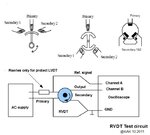Follow along with the video below to see how to install our site as a web app on your home screen.
Note: This feature may not be available in some browsers.
Mentioned transducers have several different implementations depending of the model or type.
they may have a built-in electronics.
So more exact info is needed for testing................
Potentiometric Transducers principle is potentiometer.
Inductive Rotary Angle Transducer can be RVDT (Rotary Variable Differential Transformer) , for test see : how to test LVDT
Mentioned transducers have several different implementations depending of the model or type.
they may have a built-in electronics.
So more exact info is needed for testing................
Potentiometric Transducers principle is potentiometer.
Inductive Rotary Angle Transducer can be RVDT (Rotary Variable Differential Transformer) , for test see : how to test LVDT
Are Inductive Rotary Angle Transducers & RVDT (Rotary Variable Differential Transformer) same things ?
For testing Inductive Rotary Angle Transducer OR RVDT (Rotary Variable Differential Transformer) , should i follow the same procedure & same testing circuit as of LVDT ?
No. ( RVDT is one member of Inductive Rotary Angle Transducer Family.)
Inductive Rotary Angle Transducer is general name for all Rotary Angle Transducers with Inductive sensing principle.
RVDT is Inductive Rotary Angle Transducer but specifically because its sensing principle is Differential Transformer
it is called Rotary Variable Differential Transformer .
For ex. other named Inductive Rotary Angle Transducers are PIPS®-based displacement transducers. (RIPS , LIPS)
Look this................
PIPS: A New Technology in Inductive Position Sensing
https://www.evrtp.com/everight_positek/pdf/Custom_Positek_Technology_Paper.pdf
RVDT (Rotary Variable Differential Transformer) and LVDT (Linear Variable Differential Transformer) have same procedure & same testing circuit.
would you show me how to test RVDT by taking any example , so i could comprehend the idea for testing them ?

tell that how do the engineers decide what to use RVDT or Inductive Rotary Angle Transducer ?
RVDT and LVDT have same working principle & same testing circuit.
View attachment 63734
Instruction is here .............
https://www.edaboard.com/threads/228939/#post977298
There are many criteria for the selection, some are...
- suitability of operating principle
- required accuracy
- requirements of the mechanical structure
- requirements of control device
what should be the applied AC supply & of what frequency ?
Should the output be varied with the varied AC supply voltage ?
Supply voltage and frequency can vary between different RVDT types.
Usually (50....15000Hz )
For test supply you can use for example 5Vac 50Hz with 100 ohm 1/4W series resistor ,
connected for protect primary against overcurrent.
Allways first thing to do before testing , find out electrical data and connections.
Coils can simply check with ohm-meter. ( only for check , are the coils damaged )
Some RVDT types have secondary midpoint output connection ( 3 secondary pins )
or both secondary separate outputs ( 4 secondary pins )
Normal differential transformer connection shown in attached picture.
During test primary ac voltage must have a constant value, change only rotor angle.
additional info...........
eFunda: Introduction to Rotational Variable Differential Transformer (RVDT)
How it Works - LVDT
Like in normal transformers , when primary voltage change then secondary voltage change too.
would you take any example of 3 secondary pins configuration (secondary midpoint output connection) ?
would you take any example of 4 secondary pins configuration (separate outputs) ?
When operating in Differential mode, the center tap of the output windings is often not used.
When we want to get much higher accuracy from our LVDT sensor (at least one order of magnitude)
we must use a LVDT sensor which is suitable for Ratiometric operation and a Ratiometric signal conditioning.
Electronics and wiring for ratiometric LVDT & RVDT : Used with 3 and 4 wire sensors
Look Circuits Examples For Use With LVDTs here
**broken link removed**
Compensating the Input to Output phase shift that naturally occurs in LVDTs.
Synchronous vs. Asynchronous Demodulation : Used with 3 and 4 wire sensors
Circuit principles...........
**broken link removed**

You can test LVDT or RVDT transducer / sensor with 3/4 wire like in this principle picture.......
View attachment 63866
Measured signals you see here...........
How it Works - LVDT
I gave you allready schematics
**broken link removed**
**broken link removed**
generally for testing any known system and device connections
we must to know the exact types of components and all data for them.
Plus of course all system schematics and parameters...etc...etc..
I would assume that the LVDT & RVDT testing is now
well-known thing for you...........
and suggest that LVDT & RVDT testing has now been studied for everybody and solved.
This is for checking secondary 1.connect channel A of the oscilloscope to the Primary ???
& connect channel B of the oscilloscope to the sec1 ????
This is for checking secondary 2.then connect channel B of the oscilloscope to the sec2 & keep channel A to the Primary ????
